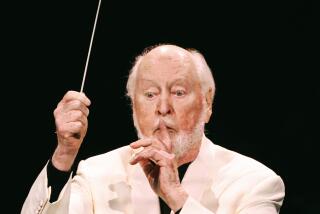Pushing All the Right Buttons : John Williams Finds Niche Carrying On Irish Squeeze-Box Tradition
- Share via
The Williams family of Doolin, County Clare, has had a long and fruitful association with squeeze boxes, but it did not begin happily.
These are Irishmen we’re talking about, so of course there is a story to be told about how the family’s musical tradition began--how it was that Johnny Williams, his son Brendan, who immigrated to America in 1957, and Brendan’s son John, who today is making the Williams name famous in traditional Celtic folk circles, all came to spend inordinate amounts of time with concertinas and accordions in their hands.
John Williams, 28, told the tale with a flourish, speaking recently from his home in the suburbs of his native Chicago. He will make his first Southern California appearance Friday, playing with an ad hoc assemblage of fellow Irish and Scottish traditional folk musicians at the Coast Hills Community Church in Aliso Viejo. Irish dancers and a French-Canadian folk-music and dance ensemble from Quebec will also perform.
The story begins with the Williams’ great-grandfather, known as “old Johnny”--a farmer, rent collector and noted carouser who “loved going out to dances and drinking. He would come home on his horse, jumping over stone walls and hedges, crazed with whiskey.”
On one such occasion, old Johnny, not having had his fill of music and dancing, rousted his son, Johnny the younger, from bed and commanded him to play the concertina, a common instrument of the day that the youngster had just received as a gift. But the groggy novice’s efforts did not please the old man.
“Mad Johnny grabbed the concertina and split it in half with a pen knife,” Williams related, “and threw it into the fire.”
Young Johnny overcame that traumatic start to emerge as a musician of note in north Clare, “very much in demand for house dances and local functions, way before the days of pubs in rural Ireland. It was said he eventually died from it. A lot of musicians suffered from being out all hours, in saunalike conditions [at crowded dances], then having to go out in the wet rain and go home. Dying of a chill was not uncommon.”
Now, the grandson of that devoted player is getting hot himself. Williams became a full-time musician in 1991, when he graduated from the University of Illinois at Chicago and decided his instrumental skills were more salable than his psychology degree.
He emerged last November with his self-titled debut CD on the Green Linnet label. It has won acclaim for its lovingly authentic yet vigorous handling of traditional Irish material.
Williams doubles as a member of Solas, a five-member Irish American band of startling instrumental and vocal firepower. Its just-released debut album on Shanachie Records allies traditional modes of playing with a freewheeling, contemporary-sounding rhythmic drive. Touring with the band (the name, pronounced “sullus,” means “light” in Gaelic) will be Williams’ main focus for the rest of this year.
First, though, comes his inaugural Southern California stop, at which he will join other soloists: banjo player Mick Moloney; fiddler Seamus Connolly; Jerry O’Sullivan, who plays tin whistle and pipes; Mark Stone on the bodhran, or hand drum; and Scottish singer-guitarist Tony Cuffe.
Williams has played with all of them before, either on stage or in after-hours jam sessions at folk festivals (the same group performs Saturday evening at the Summer Solstice Festival in Calabasas, an annual folk-arts gathering whose organizers are branching into Orange County for the first time with Friday’s concert).
“I would like to say it’s well-rehearsed, but in many cases [such pickup shows are] not,” Williams said. “It does lead to a great amount of spontaneity. It sounds like it’s going to be a riot--it’s a real pleasure for us as individuals to get away from our normal circles and ways of doing things, and just be cast into a stewpot and see what comes out.”
Williams began to play accordion and concertina at age 8; he got his early introduction to traditional Irish music by tagging along with his father, a butcher by trade but a squeeze-box player by family tradition.
“I would go to meetings of the Irish Musicians’ Assn. of America with my dad. It was formed in the 1940s, when there was fear of the music dying. These people saw themselves as crusaders for a cause to keep Irish traditional music alive in America.
“Now, in the last 10 or 15 years, it is alive and well. Hats off to them, and many other organizations in Boston, Philadelphia, New York, Cleveland--places that did support Irish traditional music as a staple of a community lifestyle back when ethnic neighborhoods were very common.”
Williams thinks he may have gotten a better and broader musical schooling in his Irish American neighborhood of south Chicago than he would have in Clare itself.
“There were tremendous musicians, people who come from all over, different parts of Ireland,” he said. “I know that until recently a lot of musicians picking up music in Clare only mingled with people inside their own parish or in neighboring parishes. I learned to play Irish music in a lot of different manners.
“My heart is with Clare music, but I have a deep appreciation for Sligo music. I’ve played music from Donegal and Belfast. When you’re a kid, you think it’s all the same, but when you get acquainted with the large body of music, you realize there are different regional styles and county styles and the repertoire differs from one to another.”
He rounded out his musical education with occasional trips to Ireland as a boy, then annual summer stays during his college years. In 1989 at a national folk contest, the Senior All-Ireland Championship, he became the first American judged best in the field on concertina. He got a further boost when he was featured on “Dear Ol’ Erin’s Isle,” a 1992 compilation of performances by Irish American musicians captured live at a concert in County Cork.
Williams’ goal on his sparsely arranged debut album, recorded in Ennis, County Clare, was to honor “the music of a place,” namely his ancestral region of Ireland. He acknowledges that the “John Williams” CD has gotten him pegged as a strict traditionalist, but he aims to broaden that conception--starting with “Solas.”
The band came together a year and a half ago when Williams joined other, New York-based players he had met on the traditional Celtic circuit--Seamus Egan, composer of “The Brothers McMullen” film soundtrack, who plays banjo, flute and tin whistle; fiddler Winifred Horan, formerly of the group Cherish the Ladies; guitarist John Doyle, formerly of the band Chanting House; and a striking newcomer, singer Karan Casey.
Solas does for Celtic music something akin to what New Grass Revival did for bluegrass, kicking away any sense of mustiness with sheer rhythmic verve, ensemble virtuosity and a modern production gleam, yet fully honoring musical roots.
“People who know me know that I’m not conservative by any means,” Williams said. “I had a very fortunate musical upbringing, and I guess I’m still being brought up, till the day I die. I have a keen understanding of my ethnic roots and where I come from and how my music has been passed on to me. I want to keep growing beyond my roots. For me, it’s a wide-open highway.”
* What: A Celtic music concert.
* When: Friday at 8 p.m.
* Where: The Coast Hills Community Church, 5 Pursuit, Aliso Viejo.
* Whereabouts: Take Interstate 5 to Alicia Parkway and go west for four miles. Turn right at Aliso Creek Road, then left at the second light, onto Pursuit. The church will be on the left.
* Wherewithal: $10. $8 in advance, available at Shade Tree Stringed Instruments, Laguna Niguel, (714) 364-5270.
* Where to call: (714) 362-0079 or (818) 342-7664.



